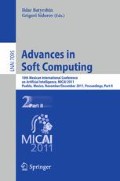Abstract
This article presents the use of Non-negative Matrix Factorization, a blind source separation algorithm, for the decomposition of human skin absorption spectra in its main pigments: melanin and hemoglobin. The evaluated spectra come from a Hyper-Spectral Image, which is the result of the processing of a Multi-Spectral Image by a neural network-based algorithm. The implemented source separation algorithm is based on a multiplicative coefficient upload. The goal is to represent a given spectrum as the weighted sum of two spectral components. The resulting weighted coefficients are used to quantify melanin and hemoglobin content in the given spectra. Results present a degree of correlation higher than 90% compared to theoretical hemoglobin and melanin spectra. This methodology is validated on 35 melasma lesions from a population of 10 subjects.
Access this chapter
Tax calculation will be finalised at checkout
Purchases are for personal use only
Preview
Unable to display preview. Download preview PDF.
References
Igarashi, T., Nishino, K., Nayar, S.K.: The appearance of human skin. Columbia Univ., New York, Tech. Rep. CUCS-02405 (2005)
Zonios, G., Dimou, A., Bassukas, I., Galaris, D., Tsolakidis, A., Kaxiras, E.: Melanin absorption spectroscopy: new method for noninvasive skin investigation and melanoma detection. Journal of Biomedical Optics 13, 14017 (2008)
Stehle, T., Auer, R., Gross, S., Behrens, A., Karssemeijer, N., Giger, M.L.: Classification of colon polyps in nbi endoscopy using vascularization features. In: Proc SPIE, vol. 7260, pp. 2s1–2s12 (2009)
Tuchin, V.V.: Tissue optics: light scattering methods and instruments for medical diagnosis. In: SPIE-International Society for Optical Engineering (2007)
Shimada, M., Masuda, Y., Yamada, Y., Itoh, M., Takahashi, M., Yatagai, T.: Explanation of human skin color by multiple linear regression analysis based on the modified Lambert-Beer law. Optical Review 7(4), 348–352 (2000)
Tsumura, N., Haneishi, H., Miyake, Y.: Independent-component analysis of skin color image. JOSA A 16(9), 2169–2176 (1999)
Jolivot, R., Vabres, P., Marzani, F.: Reconstruction of hyperspectral cutaneous data from an artificial neural network-based multispectral imaging system. Computerized Medical Imaging and Graphics 35(2), 85–88 (2011)
Mansouri, A., Marzani, F.S., Gouton, P.: Neural networks in two cascade algorithms for spectral reflectance reconstruction. In: IEEE International Conference on Image Processing, ICIP 2005, vol. 2, pp. 718–721 (2005)
Jolivot, R., Vabres, P., Marzani, F.: Validation of a 2d multispectral camera: application to demartology/cosmetology on a population covering five skin phototypes. In: SPIE 2011 (2010)
Martelli, F., Del Bianco, S., Ismaelli, A., Zaccanti, G.: Light Propagation through Biological Tissue and Other Diffusive Media (2010)
Shimada, M., Yamada, Y., Itoh, M., Yatagai, T.: Melanin and blood concentration in human skin studied by multiple regression analysis: experiments. Physics in Medicine and Biology 46, 2385 (2001)
Anderson, R.R., Hu, J., Parrish, J.A.: Optical radiation transfer in the human skin and applications in in vivo remittance spectroscopy. In: Bioengineering and the Skin: Based on the Proceedings of the European Society for Dermatological Research Symposium, p. 253. Springer, Heidelberg (1981)
Keshava, N., Mustard, J.F.: Spectral unmixing. Signal Processing Magazine, IEEE 19(1), 44–57 (2002)
Mitra, J., Jolivot, R., Vabres, P., Marzani, F.S.: Source separation on hyperspectral cube applied to dermatology. In: Society of Photo-Optical Instrumentation Engineers (SPIE) Conference Series, vol. 7624, p. 116 (2010)
Mitra, J., Jolivot, R., Vabres, P., Marzani, F.: Blind source separation of skin chromophores on a hyperspectral cube. In: ISBS International Symposium (2009)
Pauca, V.P., Piper, J., Plemmons, R.J.: Nonnegative matrix factorization for spectral data analysis. Linear Algebra and its Applications 416(1), 29–47 (2006)
Lee, D.D., Seung, H.S.: Learning the parts of objects by non-negative matrix factorization. Nature 401(6755), 788–791 (1999)
Lin, C.J.: Projected gradient methods for nonnegative matrix factorization. Neural Computation 19(10), 2756–2779 (2007)
Wang, W., Zou, X.: Non-negative matrix factorization based on projected nonlinear conjugate gradient algorithm. In: ICA Research Network International Workshop (ICARN 2008), pp. 5–8 (2008)
Comon, P., Jutten, C.: Handbook of Blind Source Separation: Independent component analysis and applications. Academic Press (2010)
Miyachi, Y.: Therapy of Skin Diseases. Springer, Heidelberg (2009)
Stone, J.V.: Independent component analysis: a tutorial introduction. The MIT Press (2004)
Author information
Authors and Affiliations
Editor information
Editors and Affiliations
Rights and permissions
Copyright information
© 2011 Springer-Verlag Berlin Heidelberg
About this paper
Cite this paper
Galeano, J., Jolivot, R., Marzani, F. (2011). Analysis of Human Skin Hyper-Spectral Images by Non-negative Matrix Factorization. In: Batyrshin, I., Sidorov, G. (eds) Advances in Soft Computing. MICAI 2011. Lecture Notes in Computer Science(), vol 7095. Springer, Berlin, Heidelberg. https://doi.org/10.1007/978-3-642-25330-0_38
Download citation
DOI: https://doi.org/10.1007/978-3-642-25330-0_38
Publisher Name: Springer, Berlin, Heidelberg
Print ISBN: 978-3-642-25329-4
Online ISBN: 978-3-642-25330-0
eBook Packages: Computer ScienceComputer Science (R0)

